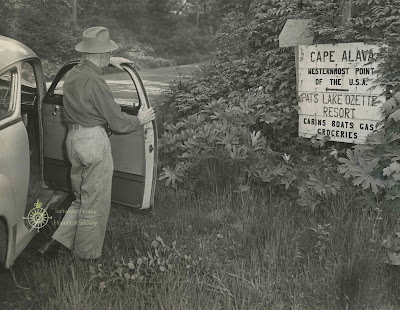Here's a little historical background of what pre-dated that launch day.
 |
| Photograph by Wally Howland c. 1970. |
The Society's first "retired" reefnet boat, as shown in the top photos, did come to be with a donation by local fisherman Lloyd Lillie, hauled up cemetery hill before the little private museum and library were even open for business. Malcolm, Wayne Fowler, and Henry Hoffman moved the reefnet boat on site in November 1968.
 |
| Shaw Island Library and Historical Society Postcard photo by summer islander, Wally Howland. These were published and sold for fund-raising at the Library. Published in the early 1970s. |
After much discussion of the Society trustees off and on over several years and a few inspections of potential replacements, the next candidate was chosen for the front garden. Their choices had dwindled to a scant few.
Unfortunately, it was decided the next retiree was a little out of scale for the site; a vessel still wearing her colorful red bottom paint and green freeboard, this more evident after it was carefully installed. Some Islanders were a little agitated about the new behemoth moored on the high-traffic corner; some jokester adorned her with graffiti on a name board inscribed SS Feng Shui, for all passersby to view. The vessel was proud on her throne at the corner but catching some unkind remarks.
 |
| Retired reefnet boat No. 2 Escorted off-site. March 2000. |
 |
| Reefnet boat number 3. Delivery day 31 March 2000 One reefnet boat ready to climb the hill to home. Click image to enlarge. |
She was not filled with styrofoam flotation like the boats that were afloat and fishing outside Squaw Bay, sadly her ladder steps were removed from the watchtower for insurance reasons, and there are no crew initials hand-carved in the gunwales.
 From across the street came the Lynnette Trucco-Baier class of school kids over to investigate and, of course, climb the tower. Delivery day of 31 March 2000 |
 |
| 31 March 2000 No fish scales but she's settling in well. |
There were a few comments afloat about the boat not being an "authentic" reefnet boat that had actually been fishing––but take a look around the past winter haul-out areas and see if any of those old-timers are above ground level. Long gone.
Thanks to charter members Gwen and Fran, our benefactors, the on-site reefnet boat logo was secured for a few more years; a fine example of islanders pulling together for the benefit of their community. Eighteen birthdays and counting.
Data for this essay was extracted from "Log of the Reefnet Boat" a historical timeline compiled by C. Christensen, containing Shaw Island Library and Historical Society board minutes (1994-2000), one page of a 1968 private diary, collected photographs for the three reefnet boats that have been parked on the grounds, as well as construction photos from Peter Christensen's Blind Bay Boatshop.














